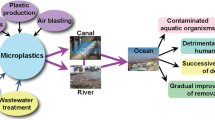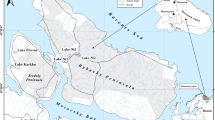Abstract
The wastewater canal Vojlovica of the Pančevo industrial area, Serbia, is the main collector of the effluents from the local industrial complex. The canal is directly connected to the Europe’s second largest river, the Danube. Here, we present a chemical and microbiological analysis of the sediment in order to determine the fate of pollutants over the years, as well as its current condition. Dry matter, clay and organic matter content, a Kjeldahl ammonia, phosphorus, metals, and polychlorinated biphenyls as well as polycyclic aromatic hydrocarbons concentrations were measured. Microbiological analysis included heterotrophic and oil-degrading bacterial counts, isolation of the phenanthrene-degrading bacteria, and identification of cyanobacteria. Generally, in comparison to the results from previous studies, concentrations of the measured pollutants have been in a decline. Specifically, the metal and polycyclic aromatic hydrocarbon concentrations were reduced whereas microbial counts and toxicity tests did not indicate significant pollution. The obtained results are probably a consequence of an improved wastewater treatment and microbial degradation of pollutants.


Similar content being viewed by others
References
Abed RMM, Köster J (2005) The direct role of aerobic heterotrophic bacteria associated with cyanobacteria in the degradation of oil compounds. Int Biodeterior Biodegradation 55:29–37. doi:10.1016/j.ibiod.2004.07.001
Alonso-Gutiérrez J, Figueras A, Albaigés J et al (2009) Bacterial communities from shoreline environments (costa da morte, northwestern Spain) affected by the prestige oil spill. Appl Environ Microbiol 75:3407–3418. doi:10.1128/AEM.01776-08
Andrade MR, Costa JAV (2007) Mixotrophic cultivation of microalga Spirulina platensis using molasses as organic substrate. Aquaculture 264:130–134. doi:10.1016/j.aquaculture.2006.11.021
Antić MP, Jovančićević B, Vrvić MM, Schwarzbauer J (2006) Petroleum pollutant degradation by surface water microorganisms (8 pp). Environ Sci Pollut Res - Int 13:320–327. doi:10.1065/espr2006.03.296
Beškoski VP, Takemine S, Nakano T et al (2013) Perfluorinated compounds in sediment samples from the wastewater canal of Pančevo (Serbia) industrial area. Chemosphere 91:1408–1415. doi:10.1016/j.chemosphere.2012.12.079
Chapman P (1990) The sediment quality triad approach to determining pollution-induced degradation. Sci Total Environ 97-98:815–825. doi:10.1016/0048-9697(90)90277-2
Chapman PM (1989) Current approaches to developing sediment quality criteria. Environ Toxicol Chem 8:589–599. doi:10.1002/etc.5620080706
Chapman PM, McDonald BG (2005) Using the Sediment Quality Triad (Sqt) in ecological risk assessment. In: Blaise C, Férard J-F (eds) Small-scale freshwater toxicity investigations. Springer-Verlag, Berlin/Heidelberg, pp 305–329
Davoren M, Ní Shúilleabháin S, Halloran JO et al (2005) A test battery approach for the ecotoxicological evaluation of estuarine sediments. Ecotoxicology 14:741–755. doi:10.1007/s10646-005-0022-8
Head IM, Jones DM, Röling WFM (2006) Marine microorganisms make a meal of oil. Nat Rev Microbiol 4:173–182. doi:10.1038/nrmicro1348
HIP Petrohemija (2012) Godišnji izveštaj - uticaj HIP Petrohemije A.D. na životnu sredinu. http://www.hip-petrohemija.com/upload/documents/razno/ORIGINAL Izve%C5%A1taj Z%C5%BDS 2012.pdf. Accessed 4 Apr 2016
HIP Petrohemija (2014a) Water Emissions. http://www.hip-petrohemija.com/corporate-responsibility/ecological-responsibility/water-emissions.117.html. Accessed 3 Apr 2016
HIP Petrohemija (2014b) Remediation. http://www.hip-petrohemija.com/corporate-responsibility/ecological-responsibility/remediation.120.html. Accessed 25 Apr 2016
HIP Petrohemija (2014c) Izvestaj o realizaciji/ucinku integrisanog sistema menadzmenta. http://www.hip-petrohemija.com/upload/documents/razno/Izv ucinku 2014 IMS.pdf. Accessed 3 Apr 2016
International Commission for the Protection of the Danube River (2008) Joint Danube Survey 2
International Commission for the Protection of the Rhine (2006) Sediment management plan rhine summary, Report No. 175
ISO 11277 (2009). Soil quality—determination of particle size distribution in mineral soil material—method by sieving and sedimentation
ISO 11348-1 (2007) Water quality—determination of the inhibitory effect of water samples on the light emission of Vibrio fischeri (Luminescent bacteria test) part 1: method using freshly prepared bacteria.
ISO 11464 (2006) Soil quality—pretreatment of samples for physico-chemical analysis
ISO 21338 (2010) Water quality—kinetic determination of the inhibitory effects of sediment, other solids and coloured samples on the light emission of Vibrio fischeri (kinetic luminescent bacteria test)
ISO 6341 (2012) Water quality—determination of the inhibition of the mobility of Daphnia magna Straus (Cladocera, Crustacea)—acute toxicity test
ISO 6878 (2004) Water quality—determination of phosphorus—ammonium molybdate spectrometric method
ISO 12846 (2012) Water quality—determination of mercury—method using atomic absorption spectrometry (AAS) with and without enrichment
Jovančićević B, Antić MP, Solević TM et al (2004) Investigation of interactions between surface water and petroleum type pollutants (9 pp). Environ Sci Pollut Res - Int 12:205–212. doi:10.1065/espr2004.12.229
Jovanović J, Jovanović M, Jovanović A, Marinović V (2010) Introduction of cleaner production in the tank farm of the Pancevo Oil Refinery, Serbia. J Clean Prod 18:791–798. doi: 10.1016/j.jclepro.2010.01.002
Kaišarević S, Varel UL, Orčić D et al (2009) Effect-directed analysis of contaminated sediment from the wastewater canal in Pancevo industrial area, Serbia. Chemosphere 77:907–913. doi:10.1016/j.chemosphere.2009.08.042
Kavka GG, Kasimir GD, Farnleitner AH (2006) Microbiological water quality of the River Danube (km 2581 - km 15): longitudinal variation of pollution as determined by standard parameters. In: Proceedings of the 36th International Conference of IAD. Austrian Committee Danube Research/IAD, Vienna., Vienna, pp 415–421
Kiviranta J, Sivonen K, Niemelä SI, Huovinen K (1991) Detection of toxicity of cyanobacteria by Artemia salina bioassay. Environ Toxicol Water Qual 6:423–436. doi:10.1002/tox.2530060407
Kohl VW (1979) The importance of bacteriological investigations for the classification of flowing water bodies, demonstrated on the Austrian part of the Danube. Veröffentlichungen der Arbeitsgemeinschaft Donauforsch 5:392–461. doi:10.1127/agdonauforschung/5/1979/392
Kolarević S, Knezević-Vukćević J, Paunović M et al (2011) The anthropogenic impact on water quality of the River Danube in Serbia: microbiological analysis and genotoxicity monitoring. Arch Biol Sci 63:1209–1217. doi:10.2298/ABS1104209K
Kostka JE, Prakash O, Overholt WA et al (2011) Hydrocarbon-degrading bacteria and the bacterial community response in gulf of Mexico beach sands impacted by the deepwater horizon oil spill. Appl Environ Microbiol 77:7962–7974. doi:10.1128/AEM.05402-11
Markou G, Georgakakis D (2011) Cultivation of filamentous cyanobacteria (blue-green algae) in agro-industrial wastes and wastewaters: a review. Appl Energy 88:3389–3401. doi:10.1016/j.apenergy.2010.12.042
Martinović-Vitanović V, Kalafatić V (2009) Ecological impact on the danube after NATO air strikes. In: Environmental consequences of war and aftermath. Springer Berlin Heidelberg, Berlin, Heidelberg
Maruyama A, Ishiwata H, Kitamura K et al (2003) Dynamics of microbial populations and strong selection for Cycloclasticus pugetii following the Nakhodka oil spill. Microb Ecol 46:442–453. doi:10.1007/s00248-002-3010-z
Meyer BN, Ferrigni NR, Putnam JE et al (1982) Brine shrimp: a convenient general bioassay for active plant constituents. Planta Med 45:31–34. doi:10.1055/s-2007-971236
Ministry of Housing Spatial Planning and the Environment (2000) Circular on target values and intervention values for soil remediation. Ministry of Housing, Spatial Planning and the Environment, Netherlands
Moscoso F, Teijiz I, Deive FJ, Sanromán MA (2012) Bioresource technology efficient PAHs biodegradation by a bacterial consortium at flask and bioreactor scale. Bioresour Technol 119:270–276. doi:10.1016/j.biortech.2012.05.095
Niewolak S (1998) Total viable count and concentration of enteric bacteria in bottom sediments from the Czarna Hańcza River , Northeast Poland. Polish J Environ Stud 7:295–306
Phang SM, Miah MS, Yeoh BG, Hashim MA (2000) Spirulina cultivation in digested sago starch factory wastewater. J Appl Phycol 12:395–400. doi:10.1023/A:1008157731731
Planojević I, Teodorović I, Bartova K et al (2011) Wastewater canal Vojlovica, industrial complex Pančevo, Serbia: preliminary ecotoxicological assessment of contaminated sediment. J Serbian Chem Soc 76:459–478. doi:10.2298/JSC100505036P
Radwan S, Al-Hasan R, Salamah S, Al-Dabbous S (2002) Bioremediation of oily sea water by bacteria immobilized in biofilms coating macroalgae. Int Biodeterior Biodegradation 50:55–59. doi:10.1016/S0964-8305(02)00067-7
Relić D, Đorđević D, Sakan S, et al. (2011) Aqua regia extracted metals in sediments from the industrial area and surroundings of Pančevo, Serbia. J Hazard Mater 186:1893–1901. doi: 10.1016/j.jhazmat.2010.12.086
Rippka R, Deruelles J, Waterbury JB et al (1979) Generic assignments, strain histories and properties of pure cultures of cyanobacteria. Microbiology 111:1–61. doi:10.1099/00221287-111-1-1
Rousk J, Bengtson P (2014) Microbial regulation of global biogeochemical cycles. Front Microbiol 5:103. doi:10.3389/fmicb.2014.00103
Smutná M, Babica P, Jarque S et al (2014) Acute, chronic and reproductive toxicity of complex cyanobacterial blooms in Daphnia magna and the role of microcystins. Toxicon 79:11–18. doi:10.1016/j.toxicon.2013.12.009
Sorkhoh NA, Al-Hasan RH, Khanafer M, Radwan SS (1995) Establishment of oil-degrading bacteria associated with cyanobacteria in oil-polluted soil. J Appl Bacteriol 78:194–199
SRPS EN 12879 (2007) Karakterizacija mulja – Određivanje gubitka žarenjem suve mase
SRPS EN 12880 (2007) Karakterizacija mulja – Određivanje suvog ostatka i sadržaja vode
Subashchandrabose SR, Ramakrishnan B, Megharaj M et al (2013) Mixotrophic cyanobacteria and microalgae as distinctive biological agents for organic pollutant degradation. Environ Int 51:59–72. doi:10.1016/j.envint.2012.10.007
Tamaki H, Sekiguchi Y, Hanada S et al (2005) Comparative analysis of bacterial diversity in freshwater sediment of a shallow eutrophic lake by molecular and improved cultivation-based techniques. Appl Environ Microbiol 71:2162–2169. doi:10.1128/AEM.71.4.2162-2169.2005
UNEP (2004) From Conflict to Sustainable Development United Nations Environment Programme Assessment and Clean-up in Serbia and Montenegro. http://postconflict.unep.ch/publications/sam.pdf. Accessed 3 Apr 2016
UNEP/UNCHS (1999) The Kosovo conflict—consequences for the environment and human settlements. http://postconflict.unep.ch/publications/finalreport.pdf. Accessed 4 Apr 2016
UNEP/UNCHS Balkans Task Force (1999) Pancevo site report—draft—. http://www.grid.unep.ch/btf/missions/sites/pancevo.pdf. Accessed 19 Mar 2016
US EPA method 3051A (2007) Microwave assisted acid digestion of sediments, Sludges, Soils, and Oils
US EPA method 3550C (2007) Ultrasonic extraction, Revision 2.
US EPA method 3620B (1996) Florisil cleanup, Revision 2.
US EPA method 3630C (1996) Silica gel cleanup. Revision 2.
US EPA method 3660B (1996) Sulfur cleanup, Revision 2.
US EPA method 7000B (2007) Flame atomic absorption spectrophotometry. Revision 2.
US EPA method 8081B (2007) Organochlorine pesticides by gas chromatography, Revision 2.
US EPA method 8270D (2014) Semivolatile organic compounds by gas chromatography/mass spectrometry (GC/MS). Revision 5.
Vujošević M, Jelena B, Vesna MV, Kalafatić V (2001) The presence of genotoxic substances in the river Danube five months after bombardment of the industrial zone of Pančevo as revealed by the allium anaphase-telophase genotoxicity assay. Acta Vet Brno 51:373–382
Yakimov MM, Timmis KN, Golyshin PN (2007) Obligate oil-degrading marine bacteria. Curr Opin Biotechnol 18:257–266. doi:10.1016/j.copbio.2007.04.006
Yuan SY, Chang JS, Yen JH, Chang BV (2001) Biodegradation of phenanthrene in river sediment. Chemosphere 43:273–278. doi:10.1016/S0045-6535(00)00139-9
Zhou HW, Luan TG, Zou F, Tam NFY (2008) Different bacterial groups for biodegradation of three- and four-ring PAHs isolated from a Hong Kong mangrove sediment. J Hazard Mater 152:1179–1185. doi:10.1016/j.jhazmat.2007.07.116
Acknowledgements
This research was financed by the Projects III43005 and TR37004 of the Republic of Serbia Ministry of Education and Science.
Author information
Authors and Affiliations
Corresponding author
Additional information
Responsible editor: Henner Hollert
Rights and permissions
About this article
Cite this article
Čučak, D.I., Spasojević, J.M., Babić, O.B. et al. A chemical and microbiological characterization and toxicity assessment of the Pančevo industrial complex wastewater canal sediments, Serbia. Environ Sci Pollut Res 24, 8458–8468 (2017). https://doi.org/10.1007/s11356-017-8513-8
Received:
Accepted:
Published:
Issue Date:
DOI: https://doi.org/10.1007/s11356-017-8513-8




